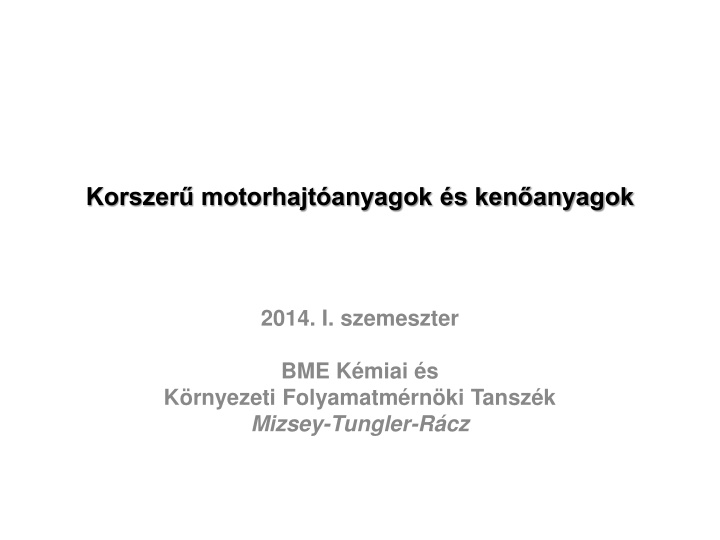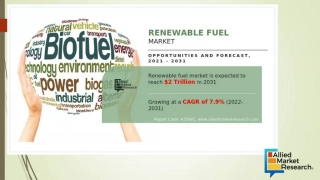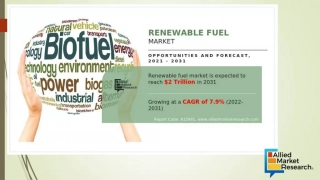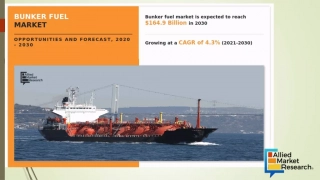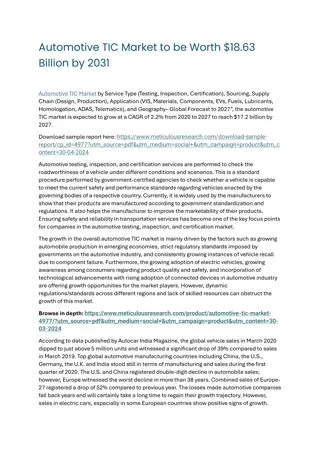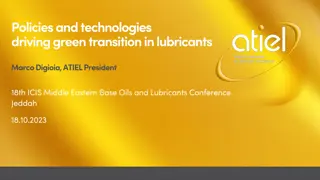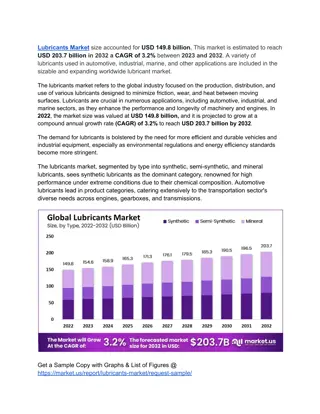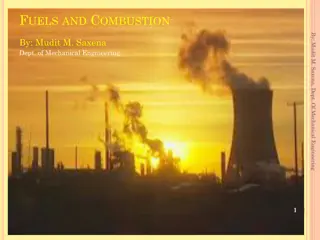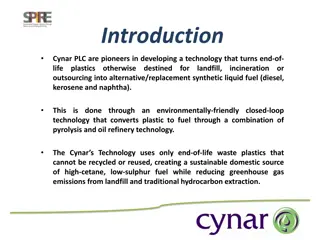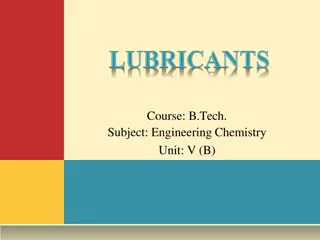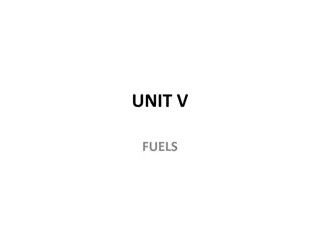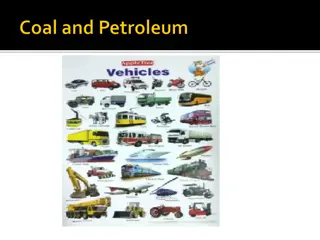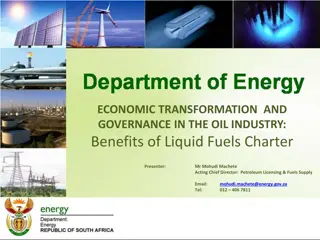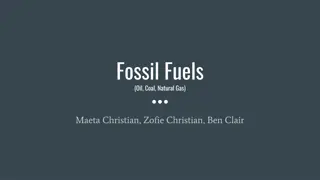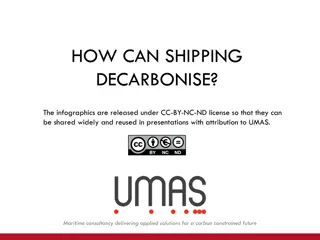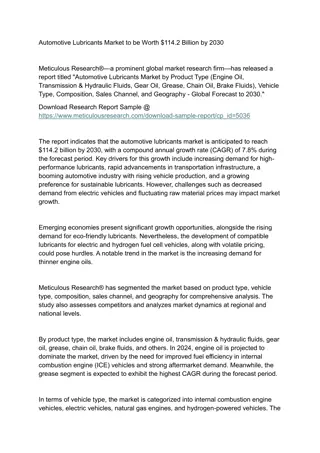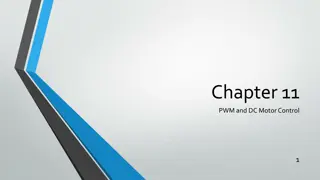Modern Motor Fuels and Lubricants Overview
Coverage of various motor fuels including traditional and alternative options for different transport modes. Explanation of lubricants used in engines and machinery for efficient performance.
Download Presentation

Please find below an Image/Link to download the presentation.
The content on the website is provided AS IS for your information and personal use only. It may not be sold, licensed, or shared on other websites without obtaining consent from the author.If you encounter any issues during the download, it is possible that the publisher has removed the file from their server.
You are allowed to download the files provided on this website for personal or commercial use, subject to the condition that they are used lawfully. All files are the property of their respective owners.
The content on the website is provided AS IS for your information and personal use only. It may not be sold, licensed, or shared on other websites without obtaining consent from the author.
E N D
Presentation Transcript
Korszer motorhajtanyagok s kenanyagok 2014. I. szemeszter BME K miai s K rnyezeti Folyamatm rn ki Tansz k Mizsey-Tungler-R cz
Mit? - k zleked si hajt anyagok - ken anyagok
Kzlekedsi hajtanyagok (fuels, kraftstoff, topliva) Bels g s motorok s sug rhajt m vek m k dtet s re szolg lnak, rendszerez s k Hagyom nyos k olajalap term kek (k olajb l sszess g ben 50% feletti hozammal), f csoportjai Motorbenzin (gasoline, petrol) a szikragy jt s Otto-, Wankel- stb. motorokhoz; Sug rhajt m zemanyag (kerosene, jet fuel) a sug rhajt s motorokhoz; D zelg zolaj (gas oil) a Diesel- stb. motorokhoz Alternat v motorhajt anyagok, f csoportjai F ldg z (CNG, LNG); Prop n-but n (LPG); Biohajt anyagok (biomassza alap etanol, ETBE, DME; NOME: RME stb.; szintetikus motorbenzin s g zolaj); Hidrog n (GH2, LH2), energiacella (fuel cell); Elektromos ram h l zatb l (plug in); Metanol gazdas g Tengerj r haj k meghajt s ra: bunkerolaj (hagyom nyos k olajalap term k)
Coverage of transport modes and travel range by the main convential and alternative fuels Rail Mode Road-passenger Road-freight Air Water Fuel Range short medium long short medium long inland short-sea maritime Natural gas LNG (biomethane) CNG LPG Gasoline Gas oil Kerosene Bunker oil Biofuels (liquid) Hydrogen (fuel cell) Electricity Alternatives as classified by the EC Transport Based on European Commission COM(2013) 17 final (24.1.2013) Clean power for transport: A European alternative fuels strategy p.4. Parliament vote is scheduled for Febr 2014 (http://hy-tec.eu/2013/10/regions-role-aknowleded-in-eu-parliament-report-on-clean- power-for-transport/). The Council is expected to agree a draft text in the form of a general approach, with reduced ambitions compared to the Commission proposal, extending the deadline to 2030 and reducing the obligations for LNG. Nevertheless, this agreement could pave the way for an agreement between EP and Council before the European Parliament elections on 24-25 May 2014 <(http://europa.eu/rapid/press-release_MEMO-13-1095_en.htm)>.
Kenanyagok (lubricants, Schmiermittel, smazki) Egym son elmozdul fel letek k zvetlen rintkez s t g tl , s rl d s- s kop scs kkent anyagok, rendszerez s k az alkalmazott g pi berendez s szerint Motorolajok; Hajt m olajok; Hidraulikaolajok; Kompresszorolajok stb. Ken zs rok Ken olajok[alapolaj k olajb l ~ 1%-os hozammal + (szintetikus olaj) + adal k]: foly kony ken anyagok, teljes tm ny (API) s viszkozit s (SAE) szerinti oszt lyoz ssal motor- s hajt m olajokn l Ken zs rok[ken olaj + g lk pz Al, Ca, Li, Na stb. szappanok]: alaktart , k pl keny anyagok, konzisztencia (NLGI) szerinti oszt lyoz ssal
Kzlekedsi hajtanyagok felhasznli (powertrains, Craftfahrzeug, transmissiya) Bels g s motorok (ICE, Verbrennungsmotor, dvigatel vnutrennovo sgoraniya):dugatty s h er g pek, benn k a motorhajt anyag szab lyozott g s sor n felszabadul termok miai energi ja - a g zok h m rs klet- s nyom ses ssel j r expanzi ja tj n mechanikai, mozg si energi v alakul. F bb t pusai Szikragy jt s Otto-motorok:a motorhajt anyag s a komprim lt leveg kever k nek g s t vez relt idej gy jt s ind tja meg; Kompresszi -gy jt s Diesel-motorok: az g st rbe bef jt, vagy befecskendezett motorhajt anyag a kompresszi k vetkezt ben felmelegedett leveg t ltett l gyullad be ( ngyullad s) Sug rhajt m vek:sug rhajt s elv n m k d j rm hajt m , h er g p s f v ka egy ttesei, a tol er a bel p leveg sug r s a kil p g sterm k-sug r reakci er inek k l nbs ge Haj kaz nok:h er g pek(g zturbin k) t lhev tett v zg z h energi j nak mechanikus energi v alak t s ra Energiacella: an d + elektrolit + kat d: a hajt anyag k miai energi j t villamos energi v alak tja. Motor Akkumul torok:villamos energia t rol s ra. Motor
A motorhajtanyagok tpust s minsgt befoly sol t nyez k biztons g- technika motor- konstrukci k k rnyezetv delem energiapolitika (vil g) hum nbiol gia energiaforr s rendelkez sre ll sa ut talak t kataliz torok motorhajt anyagok r szecskesz r k, - get k zleti fog sok gazdas goss g adal kok ken anyagok hagyom nyok Forr s: Hancs k Jen : kol gia, Regionalit s, Vid kfejleszt s Nemzetk zi Ny ri Egyetem s Workshop, Sz zhalombatta, 2008.08.11-14. 7 I
A gpjrmgyrts vltozsait s tendenciit befoly sol t nyez k K SZLETEK FELHASZN L SA FOGYASZT I IG NYEK KIEL G T SE K RNYEZETV DELEM Hajt anyag-takar koss g Megb zhat s g Komfort K ros kibocs t sok jrafelhaszn lhat s g Kevesebb karbantart s ltal nos hajt anyag-min s g Korm nyzati int zked sek Kis k lts gek Tribol gia Motortechnol gia Hajt anyag-technol gia Motorolaj-technol gia UT TALAK T KATALIZ TOROK Forr s: Hancs k Jen : kol gia, Regionalit s, Vid kfejleszt s Nemzetk zi Ny ri Egyetem s Workshop, Sz zhalombatta, 2008.08.11-14. 8
Mirt? - folyamatos kih v sokkal ( ghajlatv ltoz s, importf gg s g, foglalkoztat s stb.) k zd ter let - a vil g legnagyobb (t keer s) c gei m velik - a k olaj-feldolgoz s s a j rm gy rt s kimagasl j vedelmet ad gazatok Magyarorsz gon
World energy consumption in CMO (cubic mile of oil) per year Today: 3 CMOpa; 50 yrs later: 6 CMOpa CMOpa Crude oil (1) Coal (0.8) Natural gas (0.6) Wood (0.2) Hydro (0.2) Nuclear (0.2) Today wind&solar: 0.01 CMOpa. 1 CMO ~ 26 billion barrels of crude oil Source: Carlson C.R. Malhotra R.: www.forbes.com (9 Aug 2010) Crude oil consumption in 2009: ~30 billion barrels [1 CMO = 1.6x1.6X1.6 Ckm = 4.1 Ckm; 1 barrel = 159 l]
IEA ETP 2012 Choosing the future energy system To achieve the 2DS (limiting the long-term increase of the global mean temperature to 2 C: the pathway to sustainability), energy-related C02emissions must be halved until 2050. ETP Energy Technology Perspectives. http://www.iea.org/etp/
IEA ETP 2012 All sectors need to contribute The core of a clean energy system is low-carbon electricity that diffuses into all end-use sectors. http://www.iea.org/etp/
IEA ETP 2012 Transport 2020 targets to reach 2DS Implement fuel economy standards through at least 2020 for LDVs and trucks in all major economies Reach 5% of the fuel mix using biofuels, transitioning to advanced biofuels ASAP Double the bus rapid transit global network Increase by 50% the high speed rail network Internalise the external cost (congestion, air pollution, etc.) of transport into fuel cost Develop international tools to incentivise international shipping and aviation decarbonisation Pursue RD&D efforts to further develop fuel cell vehicles http://www.iea.org/etp/
IEA ETP 2012 The extended 2DS transport In Extended 2DS, global transport energy use remains fairly flat after 2050 as activity growth slows and efficiency improvements continue. http://www.iea.org/etp/
Emission factors of different transport fuels Fuels Natural gas LPG Aviation gasoline Gasoline Jet fuel Diesel fuel Residual (bunker) oil (#6) kg CO2 / GJ 56.06 (100) 63.20 (113) 69.11 (123) GJ / l GJ / t 0.035 GJ/st.m3 0.0249 0.0343 0.035 GJ/st.m3 45.9779 44.5900 69.25 (124) 70.72 (126) 74.01 (132) 77.3 (138) 0.0344 0.0371 0.0405 43.5674 44.5900 44.1667 40.7586 Relative emission factors (compared to natural gas s) GJ is based on lower heating values. Source: viewed 10 Feb, 2014, www.ghgprotocol.org/files/ghgp/tools/co2-mobile.pdf.
Transport : Additional investments IEA ETP 2012 . The cost of decarbonising the transport sector accelerates after 2030 as greater investments are made in advanced vehicles and low-carbon options in air, shipping and rail. USD trillion = 10 12 USD http://www.iea.org/etp/
Ten goals for a competitive, resourse efficient transport system for 60% GHG emissions reduction target (1/3) Source: White paper. Roadmap to a single European transport area. European Commission, Brussels, 28.3.2011. COM(2011) 144 final
Ten goals for a competitive, resourse efficient transport system for 60% GHG emissions reduction target (2/3) Source: White paper. Roadmap to a single European transport area. European Commission, Brussels, 28.3.2011. COM(2011) 144 final
Ten goals for a competitive, resourse efficient transport system for 60% GHG emissions reduction target (3/3) Source: White paper. Roadmap to a single European transport area. European Commission, Brussels, 28.3.2011. COM(2011) 144 final
-Overhauled energy taxation rules of 2011 (would be valid from 2018) - EU alternative fuels strategy of 2013 (and Directive on the deployment of alternative fuels infrastructure 2013)
EU Climate and Energy Package (20-20-20) 20% cut of GHG emissions by 2020 compared to 1990 level In ETS increasing share of auctioning (20% in 2013 gradually increasing to 70% in 2020). But, power producers: 100% from 2013, excluding 10 MSs (HU etc start at 30% in 2013 gradually rising to 100% in 2020). Plus solidarity mechanism for 14 countries (incl. HU): increased amounts of allowances allowed to auctioning Legally binding 120 g CO2/km (130 through vehicle technology and 10 standards through air cond, tyres etc) of new passenger cars from 2012 (65% of the car fleet by 2012, 75% by 2013, 80% by 2014 and 100% by 2015). Plan for 2020: 95 g/km. Non-compliers will be penalised (Eur 5, 15, 25, 95 per excess gram) (Reg. EC No. 443/2009) Promotion and funding of 12 demonstration CCS plants 20% energy efficiency improvement by 2020 compared to the forecast (i.e. -1,5%/yr) through action plan (2007-12) 20% renewable share by 2020 in overall energy consumption [RED-2009/28/EC] 10% biofuels in transportation fuels by 2020 Fuel suppliers have to decrease by 6% GHG (CO2, CH4, N2O) emissions over the entire life- cycle of their products (addition of biofuels, decreasing CO2 from refining). An additional 4% may be required from fuel co.-s (via supplying energy for electric vehicles, or other clean technologies, incl. CDM) [FQD-2009/30/EC] Adopted by the EU Council on 6 Apr 2009 _______________________________________________________________________________ European Commission proposal for 2030 (European Council decision expected in June 2014, draft law by early 2015) (40-..-27): - 40% cut of GHG emissions compared to 1990 level (would be -32% w/t intervention) - Continued improvements in energy efficiency (to be reviewed in July 2014) - 27% renewable share in overall EU energy consumption (binding only for the bloc). - Yearly average investments required b/n 2020&2030 amount for Euro billion 38. Based on: viewed 23 Jan 2014, <http://ec.europa.eu/clima/policies/2030/index_en.htm>.
Talking points CO2 in EU Transport Well-to-wheel analysis should form the basis for for policy developments GHG life-cycle emissions per unit of energy Production in Europe covered by ETS Combustion of unit of energy 85% Crude Production 1 4 % Distribution & retail 1% Refining 8 10 % WELL TO TANK ~15% (production) TANK TO WHEEL ~85% (consumption) WELL TO WHEEL 22 Source: CONCAWE
CO2 emissions limits for vans Amendment of reg 443/2009 as of 31 March 2011 Legally binding 175 g CO2/km of light vans up to 3.5 tons (2014: 70% of the fleet, 2015: 75%, 2016: 80%, 2017 : 100%) Penalty from 2014 for non-compliance: max of Euro 95 per car for exceeding the target By 2014, Commission may propose to extend to minibuses and vans up to 12 tons Source: Council of the European Union, Brussels, 31 March 2011, 8406/11, PRESSE 86
Pending proposals to overhaul energy taxation Now: VAT + min. excise taxes on m3 of fuels (from 2010 for unleaded petrol: 359, gasoil: 330, kerosine: 330, LPG: 125, NG: 2.6) From 2013 in support of sustainable growth: VAT + min. taxes with 2 elements Based on CO2 emissions: Euro 20 per tonne of CO2 emissions Based on energy content: Euro 9.6/GJ for transport fuels (petrol: 334, gasoil: 371); Euro 0.15/GJ for heating fuels (incl. coal) - Expected to enter into force as of 2013 with long transitional periods until 2023 Minima proposed to be reached by 2018: petrol: 360, gas oil: 390, kerosene: 392, LPG: 500, NG: 10.7 Also significant minimum tax raises for heating fuels (gas oil, kerosene, fuel oil, LPG, NG, coal and coke) and modest raise for electricity Impacts on motor fuels: due to the neutral taxes increase in diesel or a reduction in gasoline rates, biofuels would be exempt from the CO2 element Nine new MSs (incl. HU, SK) would not have to implement the CO2 element until 2020 - - - - Sources: http://europa.eu/rapid/pressReleasesAction.do?reference=MEMO/11/238&format=HTML&aged=0&language=EN&guiLangua ge=en 13 Apr 2011 http://ec.europa.eu/taxation_customs/taxation/excise_duties/energy_products/legislation/index_en.htm 2 Feb 2013 http://ec.europa.eu/taxation_customs/taxation/excise_duties/energy_products/legislation/index_en.htm 12 Feb 2014
EU alternative fuels strategy for 2020, issued in 2013 Clean power for transport : gradually replace oil with alternative fuels and build up the necessary infrastructure savings on the oil import bill, additional jobs, lower CO2 emissions Covers selected fuels and all modes of transport: LPG: road-passenger, road-freight, water (inland and short-sea) [in 2011 accounts for 3% of motor fuels, core infrastructure is already established; no new action is foreseen] LNG: road-passenger, road-freight, rail, water (inland, short-sea, maritime) [in 2011, 83 ports, and 38 road filling stations; port refuelling stations to be installed in all the EU 139 maritime and inland ports by 2020 and resp. 2025 + fixed or mobile truck refuelling stations are to be installed every 400 km along the roads of the TECN trans European core network] CNG: road-passenger, road-freight (excl. long range) [in 2011 0.5% of the car fleet used it; ten-foldinrease by 2020, EU-wide refuelling points, with common standards with max distances of 150 km by 2020] Electricity: short-range road (passenger and freight), rail [today varying situation in the EU; significant (in HU thousand-fold) increase of recharging points using a common plug is required by 2020] Biofuels (liquid): road-passenger, road-freight, air, rail, water [already nearly 5% of the fuel market; their sustainability shall be ensured (10% is expected by 2020 according the 2009/28/EC directive)] Hydrogen (in fuel cells): road-passenger, road-freight, rail, water (inland) [today varying situation in the EU and around 120 filling stations in place] to form a network with common standards for 14 EU states which currently have a hydrogen network Source: http://eur-lex.europa.eu/LexUriServ/LexUriServ.do?uri=COM:2013:0017:FIN:EN:PDF 2 Feb 2013
For Light Duty Vehicles an evolutionary roadmap may deliver substantial CO2 improvements by a variety of technologies .. 26 BiW: Body in White (g pj rm karossz ria)
as well as for Heavy Duty Vehicles in addressing rolling resistance, aerodynamic drag and drive-train efficiency improvements. Aerodynamic trailers Aerodynamic fairings Waste heat recovery Electric waterpumps 10% 6% 6,5% 4% Tyre pressure adjustment Automated transmission Low rolling Resistance tyres Single wide tyres 8% 5% 10% 10% 10% = anticipated fuel savings. Should not be added. Source: Ricardo 27
Aviation: By 2020, technology improvements will reduce fuel consumption by 21 %; up to 50 % beyond 2020 Timelines and examples of technologies Impact Retrofits 7-13% Winglets mounted on the wingtips of aircraft improve aerodynamics and reduce fuel burn More advanced engine components for better combustion and airflow Lighter materials for furnishing in the cabin Less energy-consuming lighting and in-flight entertainment Production Updates 7-18% More airframe structure components made of lightweight composite material instead of aluminium Advanced engines for current aircraft production series New aircraft design before 2020 25-35% Geared turbofan engine will reduce fuel burn 10-15% Open rotor engine will reduce fuel burn around 25% Counter-rotatingfan will reduce fuel burn 10-15% Advanced turbofan will reduce fuel burn around 15% Laminar flow reduces aerodynamic drag by reducing turbulence on aircraft surface, 10-15% less fuel burn New aircraft design after 2020 25-50% Blended wing body, rather than the classical tube-and-wing architecture Revolutionary engine architectures Fuel cell system for on-board energy Source: IATA 28
IMO: Technology and operation measures could reduce marine CO2 emissions from shipping by up to 60%....... Natural gas when stored in a liquified stage as LNG could be an attractive fuel for a few categories of ships ( coastwise shipping ) It is questionable in a non-regulated world, whether biofuels would be applied due to poor economics, some operability issues and even more so by limited availability. Source: IMO 29
A vilg legnagyobb olaj- s gzcgei s autgyrti Upper decile from Fortune Global 500 (July 23, 2013) For fiscal yr ended Jan 31 2013 No C g Bev tel Profit Global 500 C g Bev tel, MrdUSD Profit, MrdUSD 1. 3. 4. 5. 6. 10. 11. 16. 17. 21. 25. 27. R.D. Shell ExxonMob Sinopec ChinaNatP BP Total Chevron Phillips 66 ENI Gazprom 153,5 Petrobras 144,1 Valero 481,7 449,9 428,2 408,6 388,3 343,3 233,9 169,6 167,9 26,6 44,9 8,2 18,2 11,6 13,7 26,2 4,1 10,0 38,1 11,0 2,1 0,2 2,7 11,8 11,0 8. Toyota Mot. 265,7 11,6 9. Volkswagen 247,6 27,9 22. GM 152,3 6,2 23. Daimler 146,9 7,8 28. 45. Ford Motor Honda M. 134,3 119,0 5,7 4,4 47. - 6(7) O&G co.-s and 2(1) car manufacturer in the first 10 - 16(15) O&G co.-s and 7(6) car manufacturers in the first 50 (upper decile) - OMV: 176. 54,8/1,8; PKN: 297. 36,9/0.7; MOL: 474. 24,7/0.7 Nissan Mot. 116,0 4,1 138,3 36. 38. 39. 46. Pemex PDVSA Statoil Lukoil 125,2 124,5 124,4 116,3
A vilg legnagyobb olaj- s gzcgei s autgyrti Best companies from Forbes Global 2000 (Apr, 2013) Assessed on sales, profits + assets & market value No C g Bev tel Profit Global 500 C g Bev tel, MrdUSD Profit, MrdUSD 5. 7. 9. 13. 17. 18. 20. 23. 26. 30. 38. 59. 64. 40. 49. ExxonMob R.D. Shell PetroCina Chevron Gazprom BP Petrobras 420,7 467,2 308,9 222,6 144 370,9 144,1 44,9 26,6 18,3 26,2 40,6 11,6 11 14. Volkswagen 254 28,6 31. Toyota Mot. 224,5 3,4 36. Daimler 150,8 8 53. Ford Motor 134,8 5,7 Total Sinopec ENI Statoil Rosneft Lukoil Statoil Lukoil 240,5 411,7 163,7 126,8 68,8 116,3 119,6 111,4 14,1 10,1 10 12,4 11,2 11 14,1 10,4 55. BMW Group 98,8 6,6 70. GM 152,3 6,2 - 14 O&G co.-s and 8 car manufacturers in the first 100 (upper 5%) - 7 O&G co.-s and 1 car manufacturer in the first 20 (upper 1%) - OMV: 304. 56,3/1,8; PKN: 651. 38,8/0.8; MOL: 660. 24,6/0.7; Neste: 1524. 23,7/0,2 ssz. 2000 38 billi 2,43 bill.
Rendszeres havi brutt tlagkeresetek nhny gazatban, 2013. I-IX., vagy I-XI. h napok, eFt gazat Fizikai fogl. Szellemi fogl. Kokszgy rt s, k olaj-feld. I-IX. J rm gy rt s I-IX. 333,7 206,7 601,8 435,4 Vegyi anyag, term k gy rt sa I-IX. 212,0 388,3 Gy gyszergy rt s I-IX. 271,3 433,8 Gumi-, m anyag, nem-f mes sv. term kek gy. I-IX. Feldolgoz ipar I-IX. 175,9 342,3 170,3 363,5 Vill.en.-, g z- s g zel ll., l gkondicion l s I-XI. 273,3 409,4 Ipar sszesen I-XI. 174,4 362,1 P nz gyi, biztos t si tev. I-XI. 191,8 408,1 Nemzetgazdas g sszesen I-XI. 153,1 282,5 A kokszgy rt s s k olaj-feldolgoz s , vm. a j rm gy rt s kimagasl tlagkeresetet ny jt gazatok Magyarorsz gon Forr s: www.ksh.hu, 2014. febr. 8. Hay 2012 guide: annual salaries for graduate in OI (process control): 33.8 kUSD pa ~ 645 kHuF / month
A motorhajtanyagok s kenanyagok helye - sszefoglal s A motorhajt anyagok s ken anyagok f forr sa ma s a k zelj v ben a k olaj. Az energiaszerkezetben ma domin ns az olaj (34%) [az olaj peaking 2025 ut nra tehet , a glob lis R/P ar ny >40] A motorhajt anyagok (benzin, k z pdesztill tumok) a k olajb l >50%-os hozammal gy rthat k. A ken anyagok az egy b term kekhez sorolhat ak, hozamuk ~1%, de n lk l zhetetlenek A j v ben fokoz d elv r s a CO2 kibocs t s cs kkent se az energiatakar koss g s az alternat v hajt anyagok r szar ny nak n vel se tj n (EU2020 a meg jul kra: 20%, a bio zemanyagokra 10%), 2050-ig jelent s v ltoz s (az olajterm kek r szar nya fel re cs kkenhet a k zleked sben) Termel i/felhaszn l i a vil g legnagyobb c gei k z tartoznak, kimagasl keresetek az olajiparban s j rm gy rt sban
Hogyan? - el ad sok - besz mol
Tmakrk, tallkozsok Energiaszerkezet, a motorhajt anyagok s ken anyagok helye Bels g s motorok s m k d s k K olaj s f ldg z keletkez se s oszt lyoz sa, tartal kok, oil peaking K olaj s f ldg z termel se, a k olaj tulajdons gai K olajfeldolgoz s, motorhajt anyag-gy rt s Alternat v motorhajt anyagok Ken anyagok, ken s Kipufog g z kezel s Hibridaut , energiacella Kis h zi feladatok, tal lkoz sok a tansz ki k nyvt rszob ban 17:15-kor: febr. 13, febr. 20, febr. 27, m rc. 6, m rc. 13, m rc. 20, m rc. 27, pr. 3, pr. 10, pr. 17, pr. 24, m j. 8, m j. 15. M j. 15. besz mol liracz@gmail.hu HW: W. Shakespeare: Lear kir ly, 3. felvon s , 2. sz n sz vege szerint re lis-e a Bolond j slata a j v k zleked s r l
